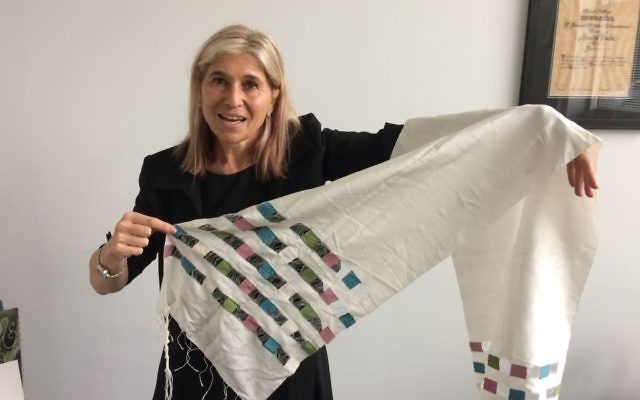Tallit-Making Rabbi to Keynote Needlework Gathering
Rabbi Bortz is most proud of her tallism, the beautiful prayer shawls she has created with her own two hands.
Rabbi Analia Bortz isn’t just another brainy Jewish overachiever.
Besides being the mother of two daughters, she is a physician with post-doctoral training in radiology and bioethics, a scholar in modern Jewish studies with the prestigious Hartman Institute in Jerusalem, and the founding rabbi, with her husband, Rabbi Mario Karpuj, of Congregation Or Hadash in Sandy Springs.
Despite her many professional accomplishments, Rabbi Bortz is perhaps most proud of her tallism, the varied and beautiful prayer shawls she has created with her own two hands.
She will be the keynote speaker Sunday night for the national convention of the Pomegranate Guild of Judaic Needlework, which runs from Sunday to Tuesday, May 21 to 23, at Le Méridien Atlanta Perimeter Hotel in Dunwoody.

The two days of how-to workshops include classes on crocheting, smocking, 3D paper cutting, knitting, needle weaving and silk applique.
For those who might want to follow the rabbi’s lead, there’s a five-hour class on “Creating the Ultimate Shawl Tallit,” the kind that drapes over the shoulders and stays put without clips.
During one recent afternoon Rabbi Bortz pulled her handiwork from a commercial shopping bag like a magician reaching into a top hat. One tallit is embroidered with the names of all the matriarchs in her family, going back to her great-great-grandmother. Another is made from a delicate silk fabric she bought from a craftsman in Laos in Southeast Asia. A third is a panel edged in lace from her childhood home in Argentina.
Altogether, over the years she has made more than 50 of these ritual garments, one for each of the young women who have had b’not mitzvah at Or Hadash since the Conservative synagogue was founded in 2003.

One of them is a fabric panel that her mother delicately hand-painted for one of Rabbi Bortz’s daughters.
Textiles and fiber art have a long and distinguished history in the practice and rituals of Judaism. They are familiar touches to the well-set Shabbat table in today’s home, but they extend back to the precise instructions we read in the Torah in recent weeks for the furnishings of the tabernacle of the wandering Israelites.
Even as the Israelites journey from one encampment to another in the Sinai wilderness, the divinely inspired priestly garments are described in minute, elaborate detail.
The lavish sense of craftsmanship is echoed in the use of art, often by prominent contemporary artists, in the modern American synagogue. One of Or Hadash’s Torah mantles, the fabric coverings for the scrolls, is the work of well-known artist Mordechai Rosenstein.
Although a young woman’s wearing of a tallit of a creative and often delicate artistic design has become commonplace in liberal Judaism, traditionalists have been less accepting of the practice.
At the Temple’s Western Wall in Jerusalem, for example, there are frequent clashes between women wearing prayer shawls and tefillin and Orthodox men protesting the women’s presence and practice.
“There is nothing in the Torah that says women can’t wear a tallit,” Rabbi Bortz said. “It must have four corners and not be a combination of wool and linen — that’s all it says. More importantly, wearing a tallit is a way of saying women are accepted.”
During her student years, she coupled her fight for acceptance as a spiritual leader with a ball of yarn and a pair of knitting needles. She created dozens of scarves and sweaters that she designed as she completed her studies, first as a medical student and later as the first female rabbi ordained in South America.

After an emotional visit to the Chagall Museum in the south of France, she took up painting to create an illustrated midrash, her personal artistic interpretations of biblical tales.
“I am a constant spiritual seeker,” Rabbi Bortz said. “If you seek G-d, you are never done. It is your companion to re-create yourself. So from the seeker’s point of view, art is something that speaks to me.”
In her keynote talk at the Pomegranate Guild convention, she plans to speak on “The Art of Living,” about how art integrates itself into modern life. As both a rabbi and a physician, she is a fervent believer in the holistic basis of well-being.
“The health of the body,” she said, “is always a manifestation of the soul. There is a balance that must be maintained between the body and the soul.”
One of her favorite artists is M.C. Escher, a Dutch graphic artist who worked in the 20th century. His mathematically inspired works often portrayed alternative levels of reality and hinted at a mysterious and endless spiral of spirituality.
“In Escher, it’s all about the partnership you have with G-d,” Rabbi Bortz said. “G-d creates, but you create and re-create. Nothing is ever finished, and one creative act brings on another.”




comments